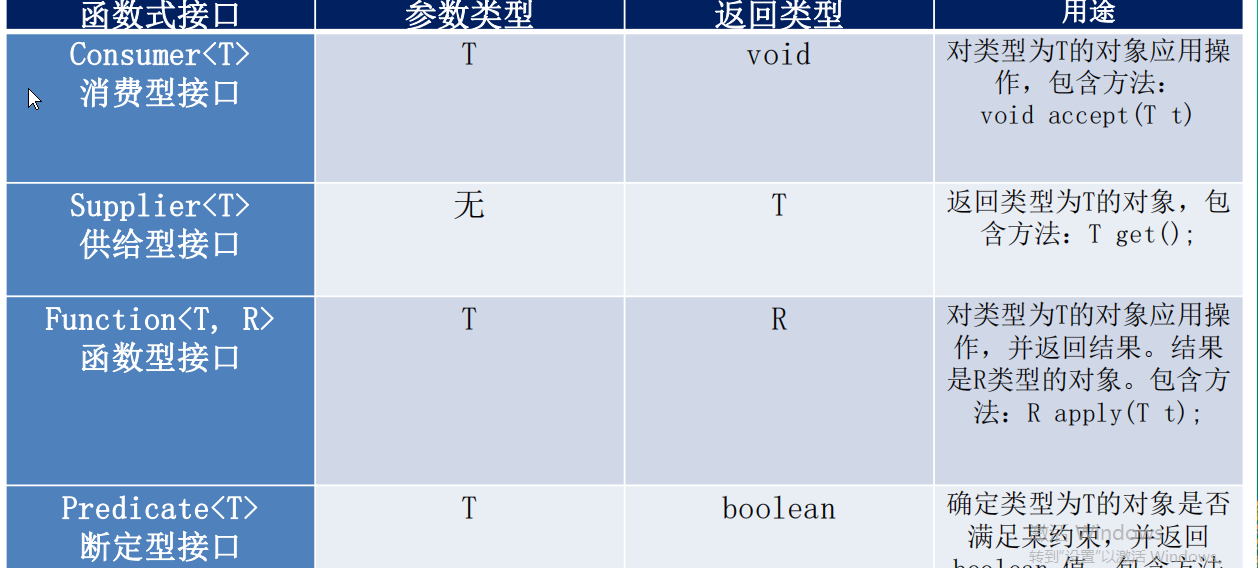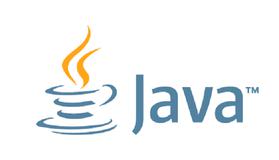Lambda 表达式的基础语法:Java8中引入了一个新的操作符->该操作符称为箭头操作符或 Lambda 操作符
箭头操作符将 Lambda 表达式拆分成两部分:
左侧:Lambda 表达式的参数列表
右侧:Lambda 表达式中所需执行的功能, 即 Lambda 体
###语法格式一:无参数,无返回值
示例:
public void test1() {
Runnable runnable = new Runnable() {
public void run() {
System.out.println("线程启动了");
}
};
runnable.run();
}
/**
* 语法格式一:无参数,无返回值
* () -> System.out.println("Hello Lambda!");
*/
public void test2() {
//“->”左边只有一个小括号,表示无参数,右边是Lambda体(就相当于实现了匿名内部类里面的方法了,(即就是一个可用的接口实现类了。))
Runnable runnable = ()->System.out.println("线程启动了");
runnable.run();
}
语法格式二:有一个参数,并且无返回值
(x) -> System.out.println(x)
示例:
public void test3() {
//这个e就代表所实现的接口的方法的参数,
Consumer<String> consumer = e->System.out.println("ghijhkhi"+e);
consumer.accept("woojopj");
}
Consumer的底层实现:
package java.util.function;
import java.util.Objects;
/**
* Represents an operation that accepts a single input argument and returns no
* result. Unlike most other functional interfaces, {@code Consumer} is expected
* to operate via side-effects.
*
* <p>This is a <a href="package-summary.html">functional interface</a>
* whose functional method is {@link #accept(Object)}.
*
* @param <T> the type of the input to the operation
*
* @since 1.8
*/
public interface Consumer<T> {
/**
* Performs this operation on the given argument.
*
* @param t the input argument
*/
void accept(T t);
/**
* Returns a composed {@code Consumer} that performs, in sequence, this
* operation followed by the {@code after} operation. If performing either
* operation throws an exception, it is relayed to the caller of the
* composed operation. If performing this operation throws an exception,
* the {@code after} operation will not be performed.
*
* @param after the operation to perform after this operation
* @return a composed {@code Consumer} that performs in sequence this
* operation followed by the {@code after} operation
* @throws NullPointerException if {@code after} is null
*/
default Consumer<T> andThen(Consumer<? super T> after){
Objects.requireNonNull(after);
return (T t) -> { accept(t); after.accept(t); };
}
}
语法格式三:若只有一个参数,小括号可以省略不写 x -> System.out.println(x)
语法格式四:有两个以上的参数,有返回值,并且 Lambda 体中有多条语句
示例代码:
@Test
public void test4() {
//Lambda 体中有多条语句,记得要用大括号括起来
Comparator<Integer> com = (x, y) -> {
System.out.println("函数式接口");
return Integer.compare(x, y);
};
int compare = com.compare(100, 244);
System.out.println(compare);
}
Comparator的底层相信大家都看过,是有一个compare()方法的。
语法格式四:若 Lambda 体中只有一条语句, return 和 大括号都可以省略不写 即:Comparator com = (x, y) -> Integer.compare(x, y);
语法格式五:Lambda 表达式的参数列表的数据类型可以省略不写,因为JVM编译器通过上下文推断出,数据类型,即“类型推断”(Integer x, Integer y) -> Integer.compare(x, y);
Lambda表达式,是需要函数式接口的支持的,那么什么是函数式接口呢?
函数式接口 ,即只包含一个抽象方法的接口,称为函数式接口。
你可以通过 Lambda 表达式来创建该接口的对象。(若 Lambda 表达式抛出一个受检异常,那么该异常需要在目标接口的抽象方法上进行声明)。
我们可以在任意函数式接口上使用@FunctionalInterface 注解,这样做可以检查它是否是一个函数式接口,同时 javadoc 也会包含一条声明,说明这个接口是一个函数式接口。像上面的Consumer接口就是一个函数式接口。
Java内置的四大函数式接口分别是:

consumer的上面已经演示过了。
下面是剩下的三个的
public void test6() {
Supplier<String> supplier = ()->"532323".substring(0, 2);
System.out.println(supplier.get());
}
public void test7() {
Function<String, String> function = (x)->x.substring(0, 2);
System.out.println(function.apply("我是中国人"));
}
public void test8() {
Predicate<String> predicate = (x)->x.length()>5;
System.out.println(predicate.test("12345678"));
System.out.println(predicate.test("123"));
}
方法引用与构造器引用
方法引用
当要传递给Lambda体的操作,已经有实现的方法了,可以使用方法引用!
方法引用就是Lambda表达式,就是函数式接口的一个实例,通过方法的名字来指向一个方法,可以认为是Lambda表达式的一个语法糖。
要求:实现抽象方法的参数列表和返回值类型,必须与方法引用的方法的参数列表和返回值类型保持一致!
方法引用:使用操作符 “::” 将类(或对象) 与 方法名分隔开来。
如下三种主要使用情况:
对象::实例方法名
类::静态方法名
类::实例方法名
"实现抽象方法的参数列表和返回值类型,必须与方法引用的方法的参数列表和返回值类型保持一致" 这句话很重要,一定要理解
我的理解是:
举个例子
Comparator
Comparator
即:方法引用的方法是Integer的compare吧,他的参数列表是两个integer类型,返回值是int,这个例子中的抽象方法是Comparator接口的compare()方法

public void test12() {
Comparator<Integer> comparator = (x,y)->Integer.compare(x, y);
Comparator<Integer> comparator1 = Integer::compare;
int compare = comparator.compare(1, 2);
int compare2 = comparator1.compare(1, 2);
System.out.println("compare:"+compare);
System.out.println("compare2:"+compare2);
}


